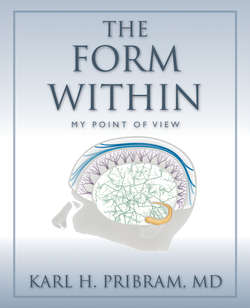Читать книгу The Form Within - Karl H Pribram - Страница 76
На сайте Литреса книга снята с продажи.
The Form(ing) of Objects
ОглавлениеOur large-scale movements allow us to experience objects. Groundbreaking research has been done by Gunnar Johanssen in Uppsala, Sweden, and James Gibson at Cornell University in Ithaca, New York. Their research has shown how objects can be formulated by moving points, such as the pixels that we earlier noted were produced by nystagmoid oscillations of the eyes. When such points move randomly with respect to each other, we experience just that— points moving at random. However, if we now group some of those points and consistently move the group of points as a unit within the background of moving points— Voilà! We experience an object. A film made by Johanssen and his students in the 1970s demonstrates this beautifully. The resulting experience is multidimensional and sufficiently discernible that, with a group of only a dozen points describing each, the viewer can tell boy from girl in a complex folk dance.
Though some of the film is made from photographs of real objects, computer programs generated most of it. I asked Johanssen whether he used the Fourier transform to create these pictures. He did not know but said we could ask his programmer. As we wandered down the hall, he introduced me to one Jansen and two other Johanssens before we found the Johanssen who had created the films. I asked my question. The programmer was pleased: “Of course, that’s how we created the film!”
But the Johanssen film shows something else. When a group of points, as on the rim of a wheel, is shown to move together around a point, the axel, our perception of the moving points on the rim changes from a wave form to an object: the “wheel.” In my laboratory we found, rather surprisingly, that we could replace the “axel” by a “frame” to achieve the same effect: a “wheel.” In experimental psychology this frame effect has been studied extensively and found to be reciprocally induced by the pattern that is being framed.
This experimental result shows that movement per se does not give form to objects. Rather, the movements must cohere, must become related to one another in a very specific manner. Rudolfo R. Llinás provided me with the mathematical expressions of this coherence in personal discussions and in his 2001 book, I of the Vortex: From Neurons to Self. My application of his expressions to our findings is that the Gabor functions that describe sensory input cohere by way of covariation; that the initial coherence produced by movements among groups of points is produced by way of contravariation (an elliptical form of covariation); and that the final step in producing object constancy is the “symmetry group” invariance produced by a merging of contravariation with covariation.
